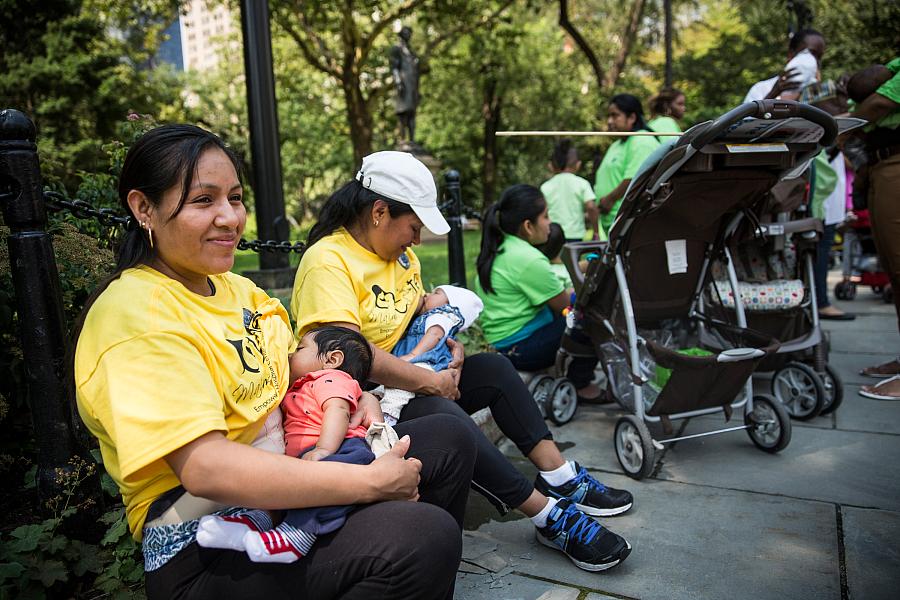More moms are breastfeeding longer, but challenges and disparities remain

Photo: Andrew Burton/Getty Images
Every two years now, the CDC issues a report card on the state on breastfeeding in the United States.
That might sound like fodder for a sleepy news day, except for the fact that the reports offer an important look at where the country stands in the long-running public health campaign to get mothers to breastfeed more and use formula less. The recently released 2016 report shows that breastfeeding rates keep trending upward, with steady gains in several key measures. It also shows big geographical disparities across states that point to the uneven nature of the gains.
The benefits of breastfeeding are well known by now. The American Academy of Pediatrics, which urges moms to breastfeed exclusively for the first six months, cites “unequivocal evidence that breastfeeding protects against a variety of diseases and conditions,” such as urinary tract infections, necrotizing enterocolitis and even diabetes. The act also helps foster a bond between mother and child, and in recent years research has emphasized how critical a responsive caregiver is in spurring brain development and moderating stress levels.
Other benefits of breast milk for babies are still being discovered. In a new book, science writer Ed Yong describes how the sugars in mother’s milk uniquely nurture beneficial bacteria in babies’ guts. “Through direct contact, B. infantis also encourages gut cells to make adhesive proteins that seal the gaps between them, keeping microbes out of the bloodstream, and anti-inflammatory molecules that calibrate the immune system,” Yong writes. Yet another new study published last month links breastfeeding to longer telomeres. Earlier studies have tied breastfeeding to modest gains in IQ and even later-in-life earnings.
So, is this enviable roster of benefits translating into more moms breastfeeding? The 2016 brief, which tracks babies born in 2013, reports that 81 percent of infants nationwide were ever breastfed; that’s compared to 79 percent reported in 2014, and 74 percent going back to 2007. The percentage of U.S. infants who were exclusively breastfed for their first six months is far lower, but still rising: 22 percent in this latest report, compared to 19 percent reported in 2014 and or 11 percent in 2007. (The report cards used to be issued annually, but now come out every two years.)
For most reporters, the more interesting data reveals how their states stack up against the national averages. Mississippi pulls up the rear in the latest numbers, with only 52 percent of babies ever breastfed, while Utah takes top honors, with more than 94 percent of infants breastfed at some point. Montana tops the nation in babies exclusively breastfed at six months, with 34 percent. Teasing apart the reasons behind any given state’s numbers and reporting on local efforts to change them make for worthy stories.
It’s also worth keeping in mind the ways in which news of forward progress on the issue can eclipse stubborn problems. As encouraging as these upward trending numbers sound, mothers still face major obstacles that are likely to put limits on future gains. Limited maternity leave and the return to work make it hard for many moms to continue breastfeeding, and unaccommodating workplaces don’t help, as Jill Lepore has noted in her short history of breastfeeding in The New Yorker:
One big reason so many women stop breast-feeding is that more than half of mothers of infants under six months old go to work. The 1993 Family and Medical Leave Act guarantees only twelve weeks of (unpaid) maternity leave and, in marked contrast to established practice in other industrial nations, neither the government nor the typical employer offers much more. To follow a doctor’s orders, a woman who returns to work 12 weeks after childbirth has to find a way to feed her baby her own milk for another nine months. The nation suffers, in short, from a Human Milk Gap.
Such difficulties explain both why the breastfeeding rates drop off so dramatically by the six-month mark and why there’s a bullish market for breast pumps. It also helps explain why poorer women are far less likely to breastfeed: Such moms are far more likely to work long hours in low-paid jobs that make few accommodations for breastfeeding, pumping or storing milk.
Barring some unexpected sea change in the country’s maternity leave policy, making workplaces more supportive of breastfeeding moms seems like the likeliest path to keeping more babies on a breast-milk diet through much of their first year. Pumps don’t help if working moms don’t have the time, space and support to use them.
**

